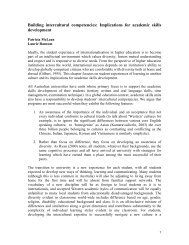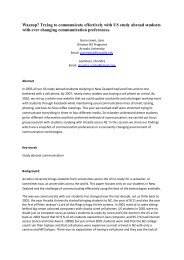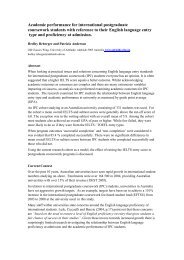Barley Breeding Australia - proceedings.com.au
Barley Breeding Australia - proceedings.com.au
Barley Breeding Australia - proceedings.com.au
You also want an ePaper? Increase the reach of your titles
YUMPU automatically turns print PDFs into web optimized ePapers that Google loves.
13 th ABTS 2007<br />
Fremantle, Western <strong>Australia</strong><br />
Guidelines for Authors - page 1<br />
<strong>Barley</strong> <strong>Breeding</strong> <strong>Australia</strong> – A New Paradigm<br />
– Working Together For A New Future<br />
Reg Lance 1 , Jason Eglington 2 , Jerry Frankowiak 3 ,Greg Platz 3 and Maarten VanGinkel 4<br />
1 Department of Agriculture and Food – Western <strong>Australia</strong>; rlance@agric.wa.gov.<strong>au</strong><br />
2 The University of Adelaide; jason.eglinton@adelaide.edu.<strong>au</strong><br />
3 Queensland Department of Primary Industries; Jerome.Franckowiak@dpi.qld.gov.<strong>au</strong><br />
3 Queensland Department of Primary Industries; Greg.Platz@dpi.qld.gov.<strong>au</strong><br />
4 Department of Primary Industries – Victoria; maarten.vanginkel@dpi.vic.gov.<strong>au</strong><br />
3 Baron-Hay Court, South Perth, Western <strong>Australia</strong>, 6151<br />
Abstract:<br />
<strong>Barley</strong> <strong>Breeding</strong> <strong>Australia</strong> has been formed as an unincorporated joint venture between: the Grains<br />
Research and Development Corporation, the Department of Primary Industries – NSW, the<br />
Department of Agriculture and Food – WA, the Department of Primary Industries and Fisheries -<br />
Qld, the Department of Primary Industries – Victoria, and the University of Adelaide. The<br />
parties agreed in March 2005 to “work together to establish an internationally <strong>com</strong>petitive, costefficient<br />
barley breeding program. The objectives of the BBA are to: a) provide <strong>Australia</strong>n<br />
growers with superior Varieties that enable them to <strong>com</strong>pete in global markets; b) meet the<br />
needs of malt, feed and special purpose end-users; c) coordinate and re<strong>com</strong>mend the release of<br />
Varieties into the <strong>Australia</strong>n Market; d) contribute to education, training and teaching programs<br />
related to barley breeding; e) foster exchange if Intellectual Property Rights among the Parties;<br />
f) exploit synergies and avoid duplication in barley breeding; and g) encourage Commercialisation<br />
of Varieties that provide overall advantages to the <strong>Australia</strong>n barley industry.<br />
Keywords:<br />
<strong>Barley</strong> <strong>Breeding</strong> <strong>Australia</strong>, malting, feed, alternate end-uses<br />
Introduction:<br />
The formation of <strong>Barley</strong> <strong>Breeding</strong> <strong>Australia</strong> has seen a major shift in the way the publicly funded<br />
breeding programs operate within <strong>Australia</strong>. Previously there were 6 main programs, now there<br />
are three nodes; BBA-North, South and West with a key role for DPI-Victoria in coordinating<br />
barley germplasm enhancement or pre-breeding. The former NSW-DPI, DPI-Vic and TIAR<br />
barley breeding programs are in the process of being phased out over the next few years with<br />
“pure” lines or reselections being advanced through their respective programs to regional stage 3 /<br />
4 trials conducted by the three BBA nodes.<br />
There have been significant shifts in the trial programs of the BBA nodes. BBA-West has<br />
responsibility for the “neutral to acid soils” of southern NSW, NE- and SW-Victoria and<br />
Tasmania. BBA-South now has responsibility for the “neutral to alkaline soils” of southern<br />
NSW, Victoria, South <strong>Australia</strong> and Western <strong>Australia</strong> (Esperance region). BBA-North has<br />
continued responsibilities for Queensland and northern NSW. The new trial programs are a<br />
reflection of both these new regions of responsibility and the transition from the previous<br />
breeding structures to the new ones. For example as the DPI-Vic program is phased out some of<br />
their trial sites will be taken over by BBA-South and BBA-West. It should be emphasized that the<br />
overall trial programs and portfolios will be under constant review with the aim optimizing<br />
efficiencies and available resources.<br />
The undertaking of new regions of responsibility has meant a rationalisation of the trial programs<br />
in other regions. For example the BBA-West will be reducing the WA trials to ac<strong>com</strong>modate the<br />
new eastern states program.<br />
Another dramatic change in the profile of the breeding programs is the new emphasis for BBA-<br />
North to concentrate on feed barleys for the domestic regional intensive animal industries. A<br />
consequence of this is that the provision of malting varieties for the northern regional will be a
13 th ABTS 2007<br />
Fremantle, Western <strong>Australia</strong><br />
joint undertaking between the three nodes <strong>com</strong>bining the adaptation and disease resistance of the<br />
BBA-North germplasm with the malting quality of BBA-South and BBA-West. Clearly this will<br />
be a major challenge for BBA.<br />
Superior Varieties:<br />
<strong>Barley</strong> breeding programs across <strong>Australia</strong> have made significant improvements with the release<br />
of the new varieties in recent years. Varieties such as DAFWA’s B<strong>au</strong>din, Hamelin and Vlamingh.<br />
The University of Adelaide’s Flagship. Fleet, and Buloke, to name a few, represent major<br />
improvements in malting quality traits for the export markets.<br />
Improving multiple resistances to diseases.<br />
A major challenge to all BBA programs will be the pyramiding of multiple disease resistances and<br />
abiotic stress tolerances into high yielding, high quality germplasm. BBA has a major role to play<br />
in the coordination of the deployment of particular genes for resistance across regions. An<br />
example of this is leaf rust resistance with the role of the National Rust Control Centre under the<br />
leadership of Prof. Robert Park. BBA breeding nodes provide an excellent way of managing the<br />
strategic deployment and release of “Pyramided” leaf rust resistance genes providing a responsible<br />
way of protecting against the possibility of new virulent races emerging against individual major<br />
genes.<br />
Scald is another disease where current major resistances are under threat. BBA again can play a<br />
lead role to devise strategies <strong>com</strong>bining known resistances with more durable genes with the aim<br />
of protecting the few available major genes. In the longer term when more is known about the<br />
genetic control of the durable resistances we will see a more strategic deployment of these latter<br />
genes across BBA programs.<br />
End-Users needs met:<br />
An important <strong>com</strong>munication and strategic input is the roles of the advisory <strong>com</strong>mittees or<br />
councils; The Western Region <strong>Barley</strong> Council, the South <strong>Australia</strong>n and South Eastern <strong>Barley</strong><br />
Advisory Committees and the Northern Region <strong>Barley</strong> Advisory Council. These groups together<br />
with major industry organisations such as <strong>Barley</strong> <strong>Australia</strong>, the Malting and Brewing Industries<br />
<strong>Barley</strong> Technical Committee (MBIBTC) and Pilot Brewing <strong>Australia</strong> facilitate broad stakeholder<br />
consultation in strategic planning and variety release decisions. It is anticipated that other groups<br />
representing the feed, food and alternate end-uses will be engaged and consulted in their areas of<br />
expertise.<br />
A number of new malting quality lines are approaching advanced testing; for example WI4262<br />
and WI4259 from BBA-South, WABARs 2312 or 2315 from BBA-West.<br />
WI3416-1572 and WABAR2321 are undergoing trials for <strong>com</strong>mercial evaluation to assess their<br />
suitability for domestic malt for domestic consumption. The collation of appropriate data and<br />
information under their respective “Commercialisation Plans” should enable informed decisions<br />
to be made concerning their suitability to different regions.<br />
The largest congregation of intensive animal industries, especially beef, are located in the<br />
northern region. BBA-North has a key leadership role in the development of high yielding,<br />
disease resistant, feed barleys for ruminant animals. The other programs will draw on the<br />
developments from this program for their own feed variety programs and thus avoid duplication.<br />
BBA-South has a long term interest in the alternate end-uses of barley especially functional<br />
foods. <strong>Barley</strong>s such as; normal, hulless, waxy, high amylopectin traits in various <strong>com</strong>binations<br />
are produced in the program. A new hulless waxy barley WI3693 has recently undergone pilot<br />
scale testing.<br />
Coordinate and re<strong>com</strong>mend the release of varieties :<br />
Guidelines for Authors - page 2
13 th ABTS 2007<br />
Fremantle, Western <strong>Australia</strong><br />
The malting and brewing industries and the marketers have expressed a need to have a more<br />
coordinated approach to the re<strong>com</strong>mendation and release of varieties into the <strong>Australia</strong>n market.<br />
BBA will play a lead role, firstly through t producing “Variety Development Plans” for each<br />
program and region to enable specific and efficient future targeting and resource allocation to<br />
meet the needs of the industry. “Commercialisation Plans” for each potential release will gather<br />
and collate relevant information indicating the merit of the new line and the justification for<br />
further testing and possible release. BBA can then oversea the more orderly targeting and release<br />
of new barleys for the region/market <strong>com</strong>bination and resolve issues where similar barleys are<br />
proposed for release<br />
<strong>Barley</strong> <strong>Australia</strong>, the Malting and Brewing Industries <strong>Barley</strong> Technical Committee (MBIBTC)<br />
and Pilot Brewing <strong>Australia</strong> have important roles in this process as does BBA’s industry partners<br />
in <strong>com</strong>mercial evaluation of varieties for both the domestic and export markets.<br />
Contributions to education, training and teaching:<br />
<strong>Breeding</strong> programs and their associated research and development programs provide excellent<br />
undergraduate and post-graduate training opportunities in breeding, genetics and molecular<br />
genetics, quality, pathology and abiotic stress tolerance including plant and crop biochemistry and<br />
physiology. The outputs from gene discovery and pre-breeding programs have a direct “path to<br />
market” enabling students and research programs to focus on training to find solutions to real and<br />
ongoing problems.<br />
Exchange of Intellectual Property Rights:<br />
Sharing of equity from newly released varieties is related to the background IPR, the input from<br />
the breeding program, and the input from the various equity partners.<br />
By way of example the new feed variety WABA2288 has the pedigree; Tantangara x VB9104.<br />
As such the owners of the two parents (NSW-DPI and DPI-Vic) will have an equity share bec<strong>au</strong>se<br />
their variety or line was used in the cross. A share goes to the other equity partners DAFWA and<br />
the GRDC.<br />
There are important consequences in sharing of IP as it has the potential to even out revenues<br />
from end-point royalties (EPRs) across programs. One program cannot exploit another’s variety<br />
in a backcrossing program for example without retuning shares to the background IP owners.<br />
Exploit synergies and avoid duplication in breeding:<br />
Before the formation of <strong>Barley</strong> <strong>Breeding</strong> <strong>Australia</strong>, there were six mainstream public breeding<br />
programs. By the end of the current phase of BBA there will only be the three BBA nodes:<br />
North, South and West. In the current phase of BBA there is a transition as three of the previous<br />
programs are “wound-down”. In this phase genetic material from reselected or effectively “pure<br />
breeding” lines are progressively moved through their respective programs and promoted to stage<br />
3 and 4 regional trials. Promotion will be on “merit” with consultation between the “owners” of<br />
the advanced lines and the various BBA-nodes responsible for the carriage of the material prior to<br />
promotion to National Variety Testing trials. For example selected germplasm from the DPI-<br />
Vic, NSW-DPI and TIAR programs could be eventually promoted on merit to stage 3 trials<br />
throughout <strong>Australia</strong>. An important collegiate consideration has been to make sure material from<br />
different programs has an opportunity to be evaluated for its appropriate fit in appropriate<br />
regions.<br />
A further example of the utilization of resources across regions can be seen in the new doubled<br />
haploids produced in the DAFWA facility. Doubled haploid plantlets in “tubs” are transported to<br />
NSW-DPI at Wagga Wagga for transplanting and “growing-out” in controlled environment<br />
rooms (CERs) and/or glasshouses. In the next generation further grow-outs will be made for seed<br />
increases in the field where screening for disease and agronomic performance can be made.<br />
Guidelines for Authors - page 3
13 th ABTS 2007<br />
Fremantle, Western <strong>Australia</strong><br />
Encourage Commercialisation of Varieties:<br />
Each BBA node is developing both “Variety Development Plans” and “Commercialisation Plans”<br />
for both justifying the release of a new line and documenting the merits and weaknesses of the<br />
line and therefore its suitability or otherwise to release in other regions. The first major test of<br />
the process will <strong>com</strong>e when for example two equivalent barleys are approaching release in the<br />
same or different regions. An important future consideration determining the longer term<br />
viability of BBA will relate to the “value” of the end-point royalties gained as revenue and their<br />
role in supplementing the programs.<br />
Challenges for the future:<br />
Addressing the dilemma of “public” verses “private” and “how to get the balance right” between<br />
these extremes will be a key issue to be resolved in the medium to long term. Under any model,<br />
the efficiency and effective use of resources together with the optimal sharing of unencumbered<br />
IP and minimal duplication is an absolute way to operate the current and future BBA programs.<br />
Climate change is a major challenge fro BBA for which the programs are able to respond. There<br />
are some clear and apparent changes occurring which should be addressed in the short term.<br />
Seasons are be<strong>com</strong>ing drier, warmer and the break to the season less predictable. Some weather<br />
patterns are be<strong>com</strong>ing more extreme; for example the incidence of frost is increasing. The<br />
development of barleys with the optimal development patterns should be a priority. As breeders<br />
we have an in<strong>com</strong>plete understanding of which gene/allele <strong>com</strong>binations are in our current<br />
varieties. We understand even less about how these genes/alleles interact with each other and<br />
with the environment. A concerted effort involving, breeders, agronomists, physiologists and<br />
molecular geneticists will be required to develop the “next generation” barleys with known and<br />
more predictive responses to changes in sowing date in different regions and in response to a<br />
changing environment. Farmers should have a choice of variety on hand, in the bin, which is<br />
appropriate to an early break or a delayed sowing opportunity.<br />
A significant issue which are fundamental to the future success of any breeding program is how to<br />
maintain and improve the rate of genetic gain. This broadly relates to gains in yield, adaptation,<br />
quality (malt, feed, food and alternate end-uses), disease resistance, and abiotic stress tolerance<br />
and being able to <strong>com</strong>bine these traits into superior varieties. The “genetic supply chain” is a<br />
continuum from germplasm introduction to variety and as such provides a “path to market” for<br />
the barley research and development groups, pre-breeding group and germplasm enhancement<br />
programs.<br />
It is critical to the future success of BBA as to how our germplasm resources and our<br />
enhancement programs are managed. It is from this process that we resource new genetic inputs.<br />
The ability of both germplasm enhancement and breeding programs to re<strong>com</strong>bine the new<br />
genes/alleles through re<strong>com</strong>bination will drive the efficiency and effectiveness of the<br />
development and integration of new genetic variation.<br />
Guidelines for Authors - page 4







